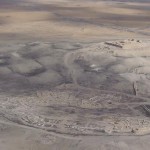 The fortress in Arad. Around 2,600 years ago, in a military fortress in Southern Judah, a man called Eliashib sent and received messages written in ink on fragments of pottery. The contents were mundane, mainly concerning food supplies, but they provide evidence of literacy that could inform the debate about when major Biblical texts were written. Eliashib’s correspondence happened on the cusp of the fall of the Kingdom of Judah, which took place during 588-87 BCE. The date plays an important role in an ongoing debate among Biblical scholars: were the first Biblical texts produced before the fall of Jerusalem—as events were unfolding—or afterwards? One part of the debate hinges on the literacy levels at the time: if the pre-demolition population wasn’t generally literate, it wouldn’t have been likely that important historical texts were created in this era. But Eliashib and his colleagues in the Arad military fortress provide some evidence that literacy in this era may have been more widespread than previously thought. A multidisciplinary group of researchers from Tel Aviv University have combined their expertise in applied math, Jewish history, and archaeology to assess communications from the fortress, trying to establish how many people, and of what rank, were writing messages. Read 8 remaining paragraphs | Comments
The fortress in Arad. Around 2,600 years ago, in a military fortress in Southern Judah, a man called Eliashib sent and received messages written in ink on fragments of pottery. The contents were mundane, mainly concerning food supplies, but they provide evidence of literacy that could inform the debate about when major Biblical texts were written. Eliashib’s correspondence happened on the cusp of the fall of the Kingdom of Judah, which took place during 588-87 BCE. The date plays an important role in an ongoing debate among Biblical scholars: were the first Biblical texts produced before the fall of Jerusalem—as events were unfolding—or afterwards? One part of the debate hinges on the literacy levels at the time: if the pre-demolition population wasn’t generally literate, it wouldn’t have been likely that important historical texts were created in this era. But Eliashib and his colleagues in the Arad military fortress provide some evidence that literacy in this era may have been more widespread than previously thought. A multidisciplinary group of researchers from Tel Aviv University have combined their expertise in applied math, Jewish history, and archaeology to assess communications from the fortress, trying to establish how many people, and of what rank, were writing messages. Read 8 remaining paragraphs | Comments
See original article:
Ancient shopping lists point to widespread Bible-era literacy





